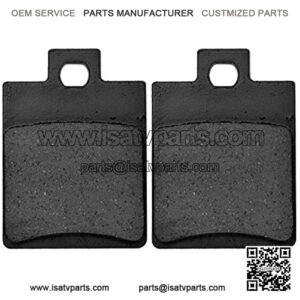You probably have a bunch of questions related to brake pads, so let’s answer some of them:
1. What Causes A Brake Pad To Crack?
If you have cracked brake pads, you can perform a visual examination.
Check the pads for small surface cracks in the center of the pads.
Here are some common causes for the cracks:
- Flexing of the brake pads
- The pads aren’t free to slide in the caliper
Note: The caliper piston can bend in the backplate due to cracked brake pads. To fix the issue, contact a mechanic for a caliper piston replacement.
2. How Does A Brake Pad Work?
Brake pads are constructed with a steel backing plate on one side, with friction material on the other side.
When you press the brake pedal in your car, the brake pad clamps down onto the rotor to slow or stop the vehicle.
3. What Is A Rotor?
A brake rotor or brake disc is a circular disc connected to each wheel (two in the front and back). This brake disc is responsible for turning motion into heat energy in the braking system and is held in place with the wheel bearing.
As the calipers squeeze your brake pads together, the large surface area of each rotor creates friction. This friction results in resistance against the spin of the wheel, which in turn slows its rotation and the car’s movement.
Note: If you notice rotor damage, get it fixed or replaced by a professional mechanic.
4. How Can You Identify Brake Pad Problems?
Your brake system tries to communicate with you through certain sounds and sensations that indicate potential brake pad problems.
Keep an eye out for the following:
- A brake squeal or grinding noise when you hit the brake.
- Shaking in your steering wheel or brake pedal.
- The brake warning light illuminates. It can mean a problem with the brake’s hydraulic system, low brake fluid levels, or your parking brake (emergency brake) may be engaged.
5. Drum Brake Vs. Disc Brake: What Are They?
An older automotive brake system often used a drum design at every wheel of a car.
In this braking system design, the components are housed in a round drum that’s rotated along with the wheel. The inside has a brake shoe made of heat-resistant friction material.
A fluid would transfer the movement of the brake pedal into the movement of the brake shoe. When you hit the brake pedal, it forces the brake shoe against the drum and slows down the wheel.
The disc brake relies on the same basic principles (friction and heat) as a drum brake, but its design is superior. Instead of keeping the major components within a metal drum, disc brakes use a slim rotor and small caliper to stop wheel movement.
There are two brake pads in a caliper — one on each side of the rotor — that clamp together when you hit the brake pedal. In this brake system, too, brake fluid is used to transfer and amplify brake pedal movement into braking force.
About Brake Pad
“brake pad”
“brake pad thickness”
“brake pads change”

